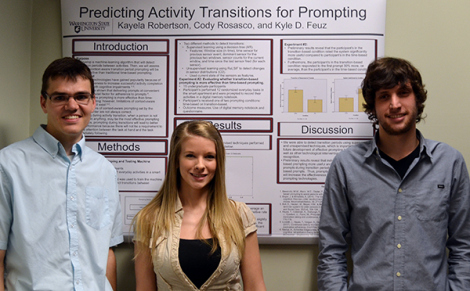Research: Predicting Activity Transitions for Prompting
Student Profiles
- Kayela Robertson, Department of Psychology. Research Focus: merging neuropsychology with technology, as well as improving rehabilitation techniques for people with traumatic brain injuries.
- Kyle Feuz, Department of Computer Science. Research Focus: detecting activity transitions for prompting
- Cody Rosasco, Department of Computer Science. Research Focus: Artificial intelligence and machine learning
Research Profile
Overview:
There are two parts to the study including 1) machine learning to detect activity transitions and 2) delivering a prompt as part of activity transitions
Resource Allocation:
Kayela & Kyle: Focus on contribution to the design, ideas, writing of papers, as well as data collection and reporting
Cody: Transition detection and script writing for algorithms so that sensor data can be generated
Research Objective:
The end goal of this project is to give the digital memory notebook to someone who has Alzheimer’s and have them actually start using it, as well as determine if it is an effective invention.
Research Methodology
Part 1, The Technology Methodology:
Participants are brought in to run through 12 activities. The first part focuses on detecting those parts as they move from activity to activity in a natural manner. They are instructed on what to go to next before they organically move on to the next step.
Subjects: Undergraduate students (currently). The long-term goal is to develop a system for older adults. There are 15 participants all being tested on the same activities (although not in the same order)
Activities: Simple tasks are included such as sweeping, watching TV, reading a magazine, dusting or doing a math problem
Quality: Performance and completion of the task is not relevant but rather the focus is observing the individual take the steps to complete each task – watching them as they do it and noting pauses, stops, transitions (i.e. going from watching TV to sweeping – do they turn off the TV and put the remote down? What are the transitional actions?)
Data Capture: While they are doing all of these activities – sensors are collecting data. The data is fed into the algorithm and transition behavior is detected and recorded.
Part 2: The Psychology Methodology
Subjects: Undergraduate students (different participants from Part 1) tested individually.
Activities: The focus is on evaluating the best time to deliver prompts. The prompts are designed for the use of the memory notebook – a tool individuals with dementia would use to write down what activities they have completed. The subjects record the activities they have accomplished and the researchers prompt them to use the memory notebook based on either time or the task they are doing. There is a time-based condition and a contact-based condition. The timed-based condition prompts the participant to use the notebook every five minutes and the contact-based condition is where they get prompts to use the notebooks during transitions. They are trying to determine whether or not it is better to give prompts during transitions or to give prompts based on time.
About the Notebook:
The notebook is like an iPad and functions like an app. It was designed off of a paper-and-pencil concept known as the memory notebook used in current intervention studies. The notebook includes a lot of different things like personal information, medications that they need to take, daily logs of what they have done that day, things that they can remember like to do lists, calendars and contact information. The preliminary data has shown that the pencil and paper intervention is very effective, so the hope is to take the digital memory notebook and make it even more effective with the use of prompting and smart home technologies. The main challenge is training individuals to use the technology.
Status of Research (Part 2):
Preliminary data has been collected to-date on about 16 subjects. Some data has been analyzed so far, yielding promising results. It shows that when participants are in the transition-based prompting condition, they tend to use the memory notebook or respond to the prompts about 30% more than the people in the time-based prompting condition. They are also asked to complete a questionnaire asking them how useful the prompting system was and people in the transition-based condition rate the system as more useful.


